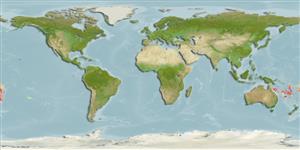Teleostei (teleosts) >
Gadiformes (Cods) >
Macrouridae (Grenadiers or rattails)
Etymology: Coelorinchus: Greek, koilos = a hollow + Greek, rhyngchos = jaw (Ref. 45335); shcherbachevi: Named for Yuri N. Shcherbachev, IOAN.
Eponymy: Yuri Nikolaevich Shcherbachev works at the P P Shirov Institute of Oceanography, Russian Academy of Sciences. [...] (Ref. 128868), visit book page.
More on authors: Iwamoto & Merrett.
Environment: milieu / climate zone / depth range / distribution range
Ecology
Marine; bathydemersal; depth range 790 - 835 m (Ref. 35908). Deep-water
Western Central Pacific: known only from south of New Caledonia on the Loyalty Ridge.
Size / Weight / Age
Maturity: Lm ? range ? - ? cm
Max length : 460 cm TL male/unsexed; (Ref. 35908)
Short description
Identification keys | Morphology | Morphometrics
Dorsal spines (total): 2. Snout 2.5 in HL; viewed dorsally somewhat duck-bill shaped, lateral margins convex, completely supported by bone; terminal scute blunt; orbits large, about equal to interorbital width, 1.6-1.7 in snout. Subopercle terminates in slender acute flap. Dermal window of light organ prominent, immediately anterior to periproct, length about 1/3 orbit diameter. Anus slightly removed from anal fin. Underside of head covered with numerous dark filamentous and flaplike papillae; almost entirely naked except for patch above end of lower jaw and at end of preopercle; nasal fossa scaled over entire ventral surfaces. Spinules on body scales strong, bladelike, with broad buttresses; arranged in 4 or 5 divergent rows. First dorsal fin uniformly dark; other fins dark to dusky; mouth dark.
A benthic species found on the continental slope (Ref. 75154). Minimum depth from Ref. 58018.
Life cycle and mating behavior
Maturity | Reproduction | Spawning | Eggs | Fecundity | Larvae
Iwamoto, T. and N.R. Merrett, 1997. Pisces Gadiformes: Taxonomy of grenadiers of the New Caledonian region, southwest Pacific. Mem. Mus. Natl. Hist. Nat. (176):473-570. (Ref. 35908)
IUCN Red List Status (Ref. 130435: Version 2024-2)
Threat to humans
Harmless
Human uses
Tools
Special reports
Download XML
Internet sources
Estimates based on models
Preferred temperature (Ref.
123201): 4.8 - 5.5, mean 5.2 °C (based on 6 cells).
Phylogenetic diversity index (Ref.
82804): PD
50 = 0.5000 [Uniqueness, from 0.5 = low to 2.0 = high].
Bayesian length-weight: a=0.00245 (0.00126 - 0.00477), b=3.19 (3.02 - 3.36), in cm total length, based on LWR estimates for this Genus-body shape (Ref.
93245).
Trophic level (Ref.
69278): 4.0 ±0.5 se; based on size and trophs of closest relatives
Resilience (Ref.
120179): Very Low, minimum population doubling time more than 14 years (Preliminary K or Fecundity.).
Fishing Vulnerability (Ref.
59153): Very high vulnerability (90 of 100).
